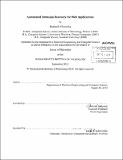| dc.contributor.advisor | Nickolai Zeldovich. | en_US |
| dc.contributor.author | Chandra, Ramesh, Ph. D. Massachusetts Institute of Technology | en_US |
| dc.contributor.other | Massachusetts Institute of Technology. Department of Electrical Engineering and Computer Science. | en_US |
| dc.date.accessioned | 2014-02-10T16:58:12Z | |
| dc.date.available | 2014-02-10T16:58:12Z | |
| dc.date.issued | 2013 | en_US |
| dc.identifier.uri | http://hdl.handle.net/1721.1/84883 | |
| dc.description | Thesis (Ph. D.)--Massachusetts Institute of Technology, Department of Electrical Engineering and Computer Science, 2013. | en_US |
| dc.description | Cataloged from PDF version of thesis. | en_US |
| dc.description | Includes bibliographical references (pages 93-97). | en_US |
| dc.description.abstract | In this dissertation, we develop recovery techniques for web applications and demonstrate that automated recovery from intrusions and user mistakes is practical as well as effective. Web applications play a critical role in users' lives today, making them an attractive target for attackers. New vulnerabilities are routinely found in web application software, and even if the software is bug-free, administrators may make security mistakes such as misconfiguring permissions; these bugs and mistakes virtually guarantee that every application will eventually be compromised. To clean up after a successful attack, administrators need to find its entry point, track down its effects, and undo the attack's corruptions while preserving legitimate changes. Today this is all done manually, which results in days of wasted effort with no guarantee that all traces of the attack have been found or that no legitimate changes were lost. To address this problem, we propose that automated intrusion recovery should be an integral part of web application platforms. This work develops several ideas-retroactive patching, automated UI replay, dependency tracking, patch-based auditing, and distributed repair-that together recover from past attacks that exploited a vulnerability, by retroactively fixing the vulnerability and repairing the system state to make it appear as if the vulnerability never existed. Repair tracks down and reverts effects of the attack on other users within the same application and on other applications, while preserving legitimate changes. Using techniques resulting from these ideas, an administrator can easily recover from past attacks that exploited a bug using nothing more than a patch fixing the bug, with no manual effort on her part to find the attack or track its effects. The same techniques can also recover from attacks that exploit past configuration mistakes-the administrator only has to point out the past request that resulted in the mistake. We built three prototype systems, WARP, POIROT, and AIRE, to explore these ideas. Using these systems, we demonstrate that we can recover from challenging attacks in real distributed web applications with little or no changes to application source code; that recovery time is a fraction of the original execution time for attacks with a few affected requests; and that support for recovery adds modest runtime overhead during the application's normal operation. | en_US |
| dc.description.statementofresponsibility | by Ramesh Chandra. | en_US |
| dc.format.extent | 97 pages | en_US |
| dc.language.iso | eng | en_US |
| dc.publisher | Massachusetts Institute of Technology | en_US |
| dc.rights | M.I.T. theses are protected by
copyright. They may be viewed from this source for any purpose, but
reproduction or distribution in any format is prohibited without written
permission. See provided URL for inquiries about permission. | en_US |
| dc.rights.uri | http://dspace.mit.edu/handle/1721.1/7582 | en_US |
| dc.subject | Electrical Engineering and Computer Science. | en_US |
| dc.title | Automated intrusion recovery for web applications | en_US |
| dc.type | Thesis | en_US |
| dc.description.degree | Ph.D. | en_US |
| dc.contributor.department | Massachusetts Institute of Technology. Department of Electrical Engineering and Computer Science | |
| dc.identifier.oclc | 868684374 | en_US |
